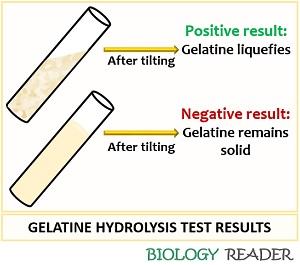Gelatin hydrolysis test is the presumptive test method to distinguish between the gelatin hydrolysing and non-hydrolysing organisms. An exoenzyme, “Gelatinase” catalyse the hydrolysis of gelatin. Gelatin hydrolysing bacteria will produce gelatinase enzyme to split the protein component of the media into simpler amino acids.
Gelatin non-hydrolysing bacteria do not produce gelatinase enzyme, which in turn do not cause hydrolysis of gelatin. The purpose of the gelatin hydrolysis test is to determine the organism’s ability to release “Gelatinase” and distinguishes between gelatin digesting microorganisms and gelatin non-digesting microorganisms based on gelatinase activity.
Content: Gelatin Hydrolysis Test
Definition of Gelatin Hydrolysis Test
Gelatin hydrolysis test is a kind of bacterial examination based on their ability to break down protein components (Gelatin) into polypeptides and later into amino acids by releasing an extracellular gelatinase enzyme. Gelatin acts as a carbon and energy source for the microorganisms that are capable of hydrolysing it. Gelatinase enzyme belongs to the group of proteases that break down the gelatin into amino acids. The bacterial cells take up the amino acid products as the amino acids are easily diffusible through the cell membrane.
What is Gelatin?
Gelatin is a compound derived from the source of animal protein or collagen. It forms after boiling the ligaments, bones, tendons of animals with water. Gelatin has broad applicability as a solidifying agent. Robert Koch was the first scientist who used gelatin nutrient media for the growth of microorganisms.
It dissolves in water at a temperature of 50 degrees C and remains solid at a temperature above 25 degrees C and liquid at a temperature below 25 degrees C. It is the substituting agent in place of agar that forms a jelly-like complex on boiling with water.
Once the gelatin breaks down, then it cannot resolidify even on refrigeration. Therefore, one can easily distinguish between the gelatin hydrolysing and non-hydrolysing bacteria by merely observing the liquefaction of gelatin media.
What is Gelatinase?
Gelatinase belongs to the group of Proteases and is a kind of proteolytic enzyme. It catalyzes the degradation of a protein compound gelatin into its sub-compounds like polypeptides, peptides and amino acids. Some prokaryotic organisms like bacteria contain gelatinase enzymes in their extracellular space.
The late log and early stationary phase of the bacteria actively produce the gelatinase enzyme. Eukaryotic organisms like humans usually contain a kind of matrix-zinc dependent metalloproteases (MMPs) like MMP -2 and MMP-9. In humans, the stomach produces the gelatinase enzyme, but it is less acidic than the digestive enzyme ‘Pepsin’.
Principle
The gelatin hydrolysis test is based on whether the organisms can digest gelatin as a sole source of protein by the gelatinase enzyme or not. Gelatin degrading bacteria will cause sequential hydrolysis of gelatin into amino acids. The gelatin-digesting microorganisms carry the amino acids away from the cell membrane for cell development and other metabolic activities.

- Hydrolysis of gelatin into polypeptides
- Hydrolysis of polypeptides into peptides
- Final break down of peptides into simpler amino acids
Gelatin hydrolysis test uses gelatin nutrient medium (Differential media) that differentiates organisms based on gelatinase activity. Gelatinase positive organisms liquefy gelation and cause liquefaction of the media, whereas gelatinase negative organisms do not liquefy the gelatin media.
Test Media
Gelatin hydrolysis test uses only gelatin nutrient media, not any chemical reagent. The composition of gelatin nutrient media per litre of distilled water requires:
Gelation: 120 grams
Peptone: 5 grams
Beef-extract: 3 grams
Final pH: 6.8 0.2 at 25 Degrees Celsius
Procedure
Gelatin hydrolysis test includes the following steps:
- First, prepare gelatin media by weighing all the components accurately and dissolving them in 1000ml of distilled water.
- Autoclave the media under 15lbp pressure for 20-30 minutes.
- Under sterile conditions, pour 3-5ml of the glucose nutrient media into several test tubes or Petri plates.
- Allow the media to solidify.
- Stab the inoculum 4-5 times ½ inch deep into the gelatin media.
- After inoculation, incubate the culture tubes or plates at 25 degrees Celsius for at least 48 hours.
- Then, take out the culture tubes from an incubator and keep them in the refrigerator at 4 degrees Celsius for a minimum of 30 minutes.
- At last, gently invert the tubes or plates to observe whether liquefaction occurred or not in the gelatin media.
Test Results
Positive result: Liquefaction in the gelatin nutrient medium occurs.
Examples: Serratia marcescens, Bacillus subtilis, Clostridium perfringes, Proteus vulgaris etc., are the organisms giving positive results for the test of gelatin hydrolysis.

Negative result: The media does not liquefy and remains solid.
Examples: Serratia typhimurium, Escherichia coli, Micrococcus roseus etc., are the organisms giving negative results for the test of gelatin hydrolysis.